#renaissance sappho
Text

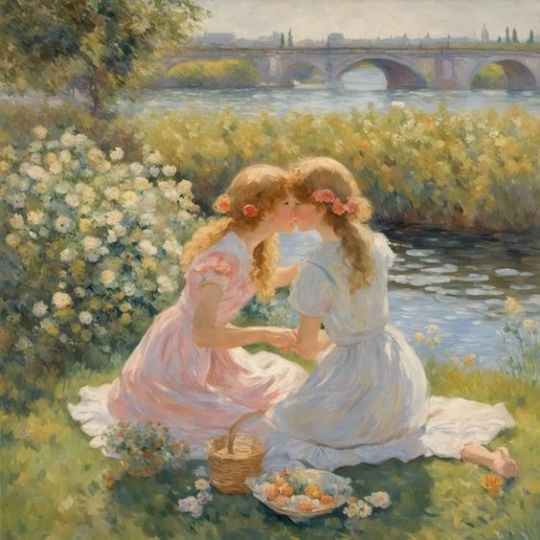




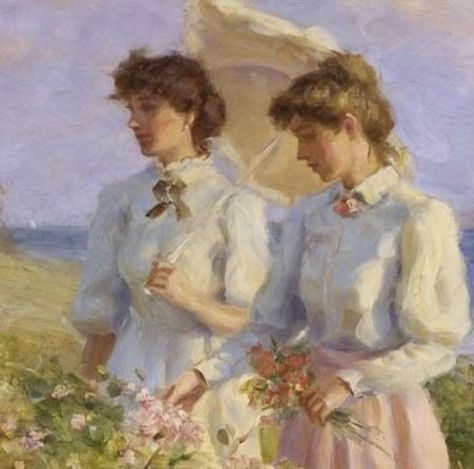
#lesbian pride#lesbianism#lesbian#sapphic#gay girls#wlw#sapphism#sappho#wlw mood#wlw community#wlw blog#wlw love#wlw post#poem#beauty#beautiful#beauttiful girls#lovely#renaissance art#flowers#cottagecore#cottage aesthetic#girl in red
630 notes
·
View notes
Text





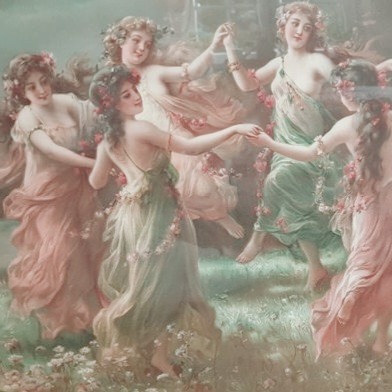
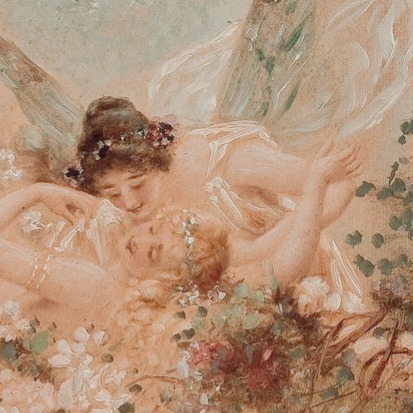

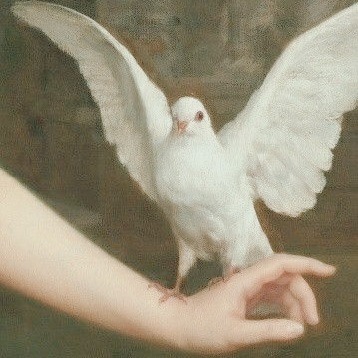
"She was all in pink, and a wreath of little pink wild roses lay close about her head, making her, with her tall young slimness, look like a Botticelli nymph."
-Frances Hodgson Burnett, The Making of a Marchioness
#dark acadamia aesthetic#dark academia#light academia#light acadamia aesthetic#classic academia#quotes#romantic aesthetic#book quotes#dark academia aesthetic#academia moodboard#royalcore moodboard#royalcore#cottagecore#sapphic#sappho#art academia#academia#chaotic academic aesthetic#classic art#renaissance art#renaissance#frances hodgson burnett#the making of a marchioness#poetry#nymph aesthetic#nymphcore
210 notes
·
View notes
Text
there’s something so greek tragedy about laudna being a dead woman walking for 30 lonely years, essentially suspended in time with an evil necromancer rattling around in her head and has no idea that this purple haired farm girl who dreams about the moon is desperately in love with her.
132 notes
·
View notes
Text
The flowers associated with Rosalie, roses and violets, are also associated with sapphic love.
#rosalie hale#twilight#the twilight saga#twilight renaissance#rosalie lillian hale#sapphic#sappho#for many crowns of violets and roses#roses#violets
7 notes
·
View notes
Text
love, lay me down under grass & sunlight, and touch me [right here] and here and here, where the ache & hurt have gone to nest. [(now again)] my fingers will find yours, tangle & sweeten the air. and the birds will cry [for] us alone
—Sappho, fragment 83
#poets on tumblr#dark academia#aesthetic#spilled poetry#words#spilled ink#spilled thoughts#19th century#vintage#love poem#dark acadamia aesthetic#dark academia books#renaissance art#renaissance#poetry#sappho
18 notes
·
View notes
Text

Women

Last and first version
#collage#recycledart#digital illustration#digital painting#woman artist#woman artwork#renaissance#art history#sapphic#sappho#flower art#flower aesthetic#femininity#feminism#slightly suggestive#quotes#sad quotes#life quotes#women and girls#emotional art#renaissance women#renaissance art
1 note
·
View note
Text
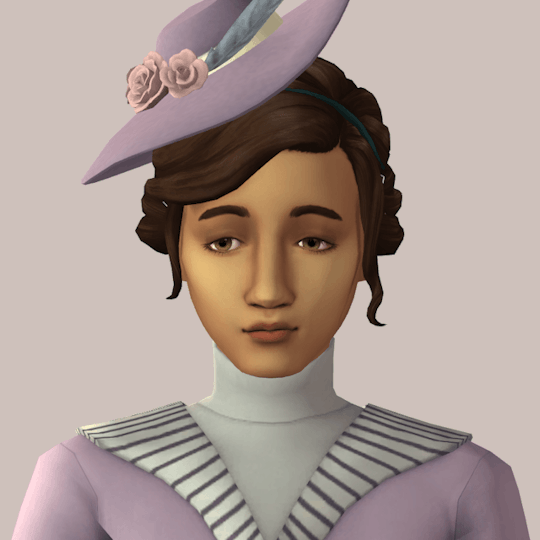

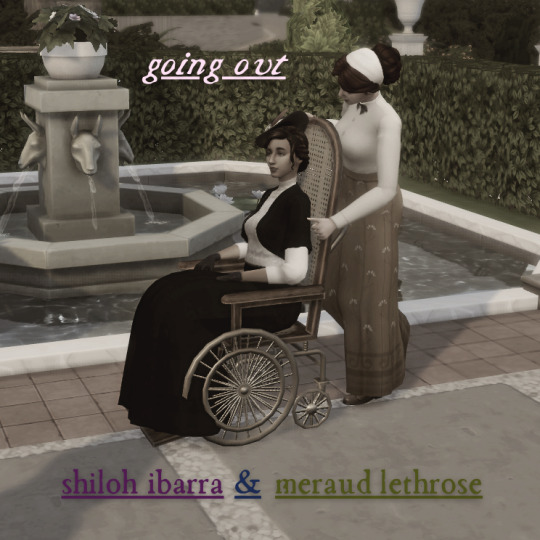

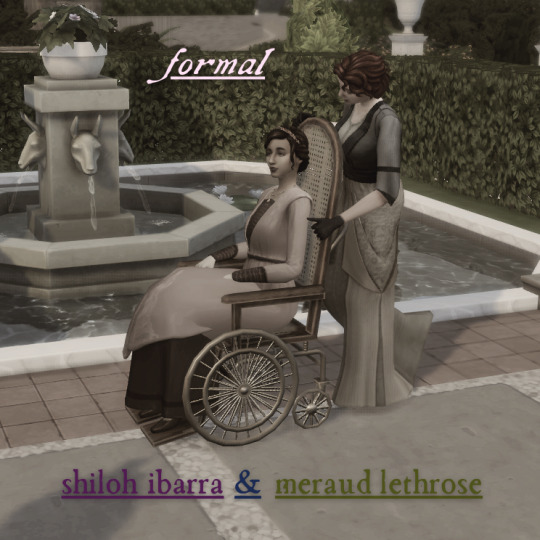


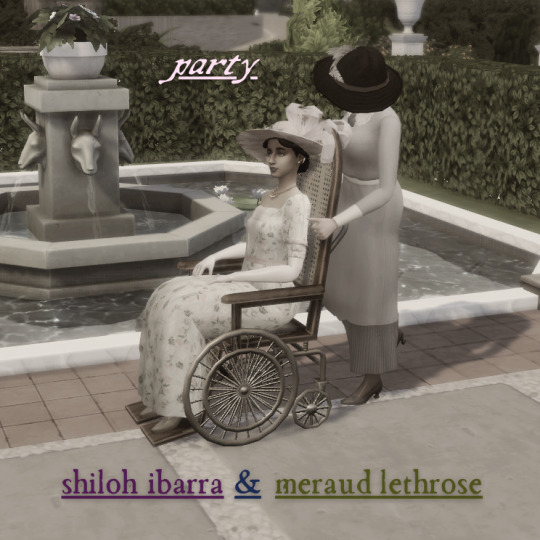
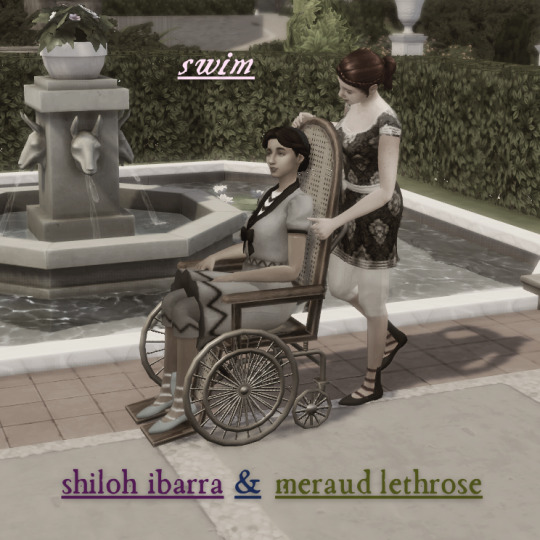
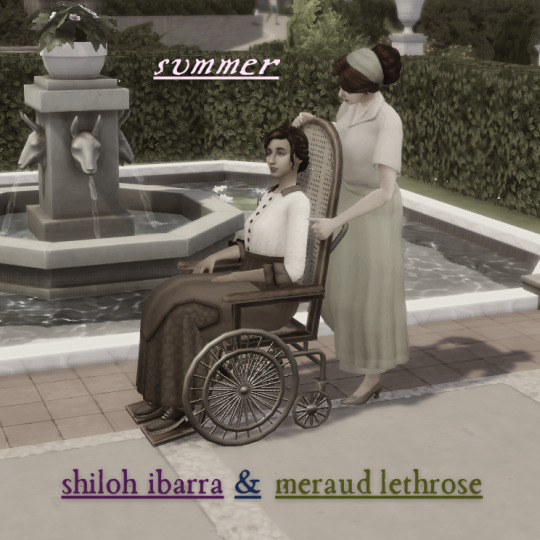


What is beautiful is good and who is good will soon be beautiful. - Sappho of Lesbos
fuck it. higher class english woman from a jewish-italian family and her cornish childhood friend-turned-housemaid that slowly fell in love over the 1910s.
on a more personal note, i don't think i can describe the big old smile on my face when i saw the antique wheelchair from @lilis-palace and the accompanying poses. disability related cc is few and far between, and finding historical disability related cc is like finding a dolphin in the desert. disabled people have always been here, and will always be here.
we've existed throughout history! shanidar one was a neanderthal who had brain damage and possible paralysis, and is estimated to have lived to be between thirty-five and forty-five – pretty old for a neanderthal! disabled people show up often in medieval and biblical texts. the greek god hephaestus is famously described as "lame," "deformed," and/or "impaired". various disabled bodies are portrayed in ancient egyptian art. some people with developmental/learning disabilities were honored by western european courts in the renaissance and believed to be closer to god. closer to the time period portrayed in this post, rosa may billinghurst was known as the "cripple suffragette" and was involved in near constant rallying for women's rights. disabled people are overlooked in studies and perceptions of history for so many reasons; mistreatment, abuse, erasure, eugenics, different ways of categorizing and labelling disabilities, and simply being lost to time and translation. but we've always existed. for every iconic figure of disability history, there's hundreds more who simply existed and had their lives forgotten.
there's names you know like helen keller, frida kahlo, franklin d. roosevelt, and names you don't. if anything i've said at all has interested you, here are a few more notable disabled people from history and modernity to research if you'd like: brad lomex, wilma mankiller, niccolò paganini, ivar the boneless, and barbara jordan.
cc used under the cut! (if it's not linked, it's from the game)
see my resources page!
all/multiple - lilis-palace's antique wheelchair + poses / rheallsim's fancy hairline / mlys' sibel rolled updo / the-melancholy-maiden's edwardian bandeau / citrlet's ivy freckles / plumbobteasociety's fancy fascinator hat / waxesnostalgic's toque hats / blueraptorsden's vintage stockings / satterlly's elizabeth boots / waxesnostalgic's edwardian heel pumps / xldkx-cc's rogue brogues
everyday - linzlu's hattie dress (download link) / sokea-cc's sweater dress
going out - dzifa's holmes dress / dancemachinetrait's priscilla set
wartime - waxesnostalgic's female war worker uniform / waxesnostalgic's v.a.d. headwear / satterlly's v.a.d. nurse uniform
formal - madameriasims4's laurel wreath headpiece / satterlly's silk dress / simlaughlove's alyssum succulents / retro-pixels astor dress
athletic - vintagesimstress's 1897 cycling hat / waxesnostalgic's armistice blouse / waxesnostalgic's female knickerbockers / waxesnostalgic's open collar blouse
sleep - vintagesimstress's 1893 aesthetic dress / sunivaa's lola dress
party - simverses's hat with plume, bow, and roses conversion / historicalsimslife's tea in the garden dress / pinkpatchy's sunless walks hat / twentiethcenturysims' fern dress
swim - linzlu's bathing belle swimsuit / eirflower's bain de soliel bathing shoes / lollaleeloosstuff's historical swimwear
summer - happylifesims' 1910's day dress #1 / waxesnostalgic's open collar blouse (short sleeves) + 1919 skirt (i think) / twentiethcenturysims golden ring accessory
winter - simverse's edwardian tapestry coat conversion / waxesnostalgic's cloche hat / linzlu's florence outerwear (download link)
thank you to @lilis-palace @rheallsim @mlyssimblr @the-melancholy-maiden @citrlet @waxesnostalgic @blueraptorsden @satterlly @xldkx-cc @linzlu @antiquatedplumbobs @sokea-cc @dzifasims @dancemachinetrait @madameriasims4 @simlaughlove @losts4cc @vintagesimstress @sunivaa @simverses @pinkpatchy @twentiethcenturysims @eirflower and @happylifesimsreblogs !!!
#my sims#sims 4 lookbook#ts4 lookbook#s4 historical lookbook#ts4 historical lookbook#ts4 disability#sorry that this turned into like. half an essay. lol.
130 notes
·
View notes
Text
Crowley was 100% besties with the renaissance thinkers. He and DaVinci were always talking about some kind of invention or painting or just making fun of people, Michelangelo let him in on all the hidden meanings in his paintings and they’d always complain to each other about their bosses, and him and Galileo talked about the stars. In fact, it was his friendship with Crowley that solidified his belief in the heliocentric model of the solar system.
Aziraphale fraternized with the Enlightenment thinkers. He discussed morals and ethics and philosophy with Kant and Rousseau, Locke and Voltaire. Unlike Crowley with the renaissance figures a couple centuries beforehand, Aziraphale shared very little of his angelic wisdom. Partially because he didn’t want to but also because everytime he’d talk with any of them they would beg him not to. This resulted in, whenever they said something completely wrong, Aziraphale trying to hide a sly smile, failing completely and having a cup of tea thrown at his head. Very pleasant.
At the start of the 20th century, Aziraphale found himself surrounded by the likes of Joyce, Woolf and Wilde. He enjoyed it immensely. Who wouldn’t? This is how he got many of his first editions from the period. Whilst he and Wilde were very close, he probably spent the most time with Woolf. Whilst modernist literature was never his favourite period, he loved the writing of Woolf, many of her shorter works he read prior to them being published, were some of the most beautiful works of prose he’d ever read. He thought that Crowley might like Huxley’s works if he liked to read but he didn’t so Aziraphale never tried to convince him to but he always keeps an extra copy of Brave New World in his bookshop just in case (it’s signed too).
Later on in the century, Crowley befriended the men whose names most people only ever expect to hear used from time to time in a science lesson but never truly understand who they were or what it was that they actually discovered. Einstein, Schrödinger, Doppler, if they changed the science world, Crowley knew them. He had a good time with them, providing little “what if”s and queries that would stop them in their tracks. Most of them initially thought he was pretty, how to put it, stupid, at first, I mean if anyone saw they way he looked at the maths they did tragedy think he was pretty brainless too despite the fact he was only trying to figure out why they had done all that maths to get a simple answer. But his value was quickly realised because, unlike his companion, Crowley was much happier to give little pieces of information he learnt during the creation of the universe.
Sorry for my rambling. Also Aziraphale and Sappho were definitely friends and he still has full copies of her poems in the back of his bookshop but he’s not gonna tell anyone about that.
#Crowley also knew Ea Nasir#Like 100%#who else would have been involved in a scam#That is still remembered millennia later?#good omens#ineffable husbands#crowley#aziraphale#aziracrow#good omens shitpost#My ramblings
36 notes
·
View notes
Text
Transcribing the Oscar Wilde Questionnaire
Because nearly every response is a gem. (Here's a link to a high-res photo of the questionnaire, completed by Wilde in 1877)

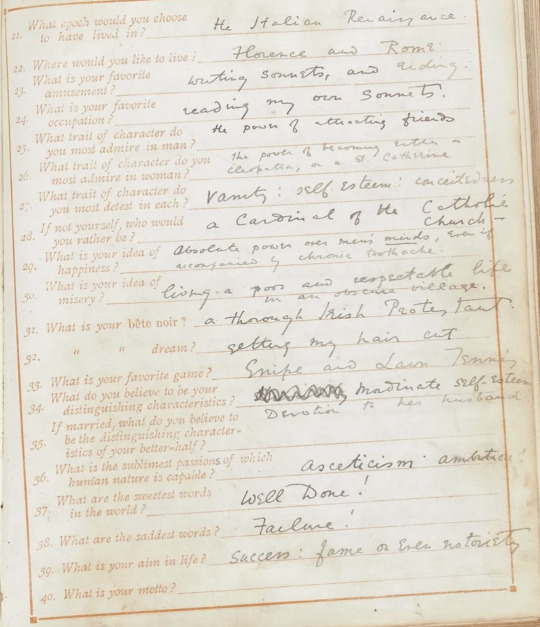
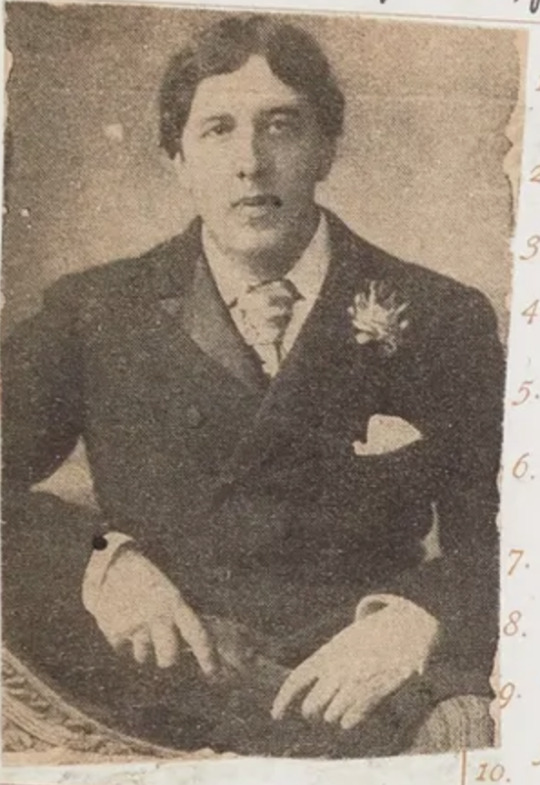
N: Oscar Fingal O'Flahertie Wills Wilde, 1877
Your Favourite
Colour? couleur de rose (often a [red?]).
Flower? Lilium Auratum
Tree? Stone Pine and Lemon Tree
Object in nature? The sea (when there are no bathing machines)
Hour in the day? Post hour.
Season of the Year? Beginning of autumn.
Perfume? almond blossoms
Gem? Sapphire in winter / Diamond in summer.
Style of Beauty? that of Guido [Reni]'s St. Sebastian and of the "Venus of Melos [sic - Milo]"
Names, Male and Female? Eucharis, Florence, Cecil
Painters? Fra Angelico; Turner; Caravaggio.
Musicians? Mozart, Gounod, Chopin.
Piece of Sculpture? Apoxyomenos of Vatican.
Poets? Euripides, Keats, Theocritus, and myself.
Poetesses? Sappho and Lady [Jane] Wilde
Prose Authors? Plato and John Ruskin.
Character in Romance? Achilles; Nausikaa
[Character] in History? Dr Newman. Alexander.
Book to take up for an hour? I never take up books for an hour.
What book (not religious) would you part with least? my Euripides.
What epoch would you choose to have lived in? the Italian Renaissance.
Where would you like to live? Florence and Rome.
What is your favourite amusement? writing sonnets, and Riding.
What is your favourite occupation? Reading my own sonnets .
What trait of character do you most admire in man? the power of attracting friends.
What trait of character do you most admire in woman? the power of becoming either a Cleopatra, or a St. Catherine
What trait of character do you most detest in each? Vanity; self esteem; conceitedness
If not yourself, who would you rather be? a Cardinal of the Catholic Church
What is your idea of happiness? Absolute power over men’s minds, even if accompanied by chronic toothache.
What is your idea of misery? living a poor and respectable life in an obscure village.
What is your bête noir [sic]? a thorough Irish Protestant
What is your dream? getting my hair cut
What is your favorite game? Snipe and Lawn Tennis
What do you believe to by your distinguishing characteristics? [the word “humility” is scribbled-through] inordinate self-esteem
If married, what do you believe to be the distinguishing characteristics of your better-half? Devotion to her husband [Note: written high in margin as cheeky reference to response in #34]
What is the sublimest passions of which human nature is capable? asceticism; ambition
What are the sweetest words in the world? Well Done!
What are the saddest words? Failure!
What is your aim in life? success, fame or even notoriety
What is your motto? [No response]
#oscar wilde#wilde#literature#poetry#my take: he has excellent taste but is also a Basic History Gay. Respect.#What is the sublimest passions of which human nature is capable? ‘asceticism’ 👀#a genuinely interesting response assuming he’s not joking
251 notes
·
View notes
Text
Also I know it's dumb to get mad at people on the internet, but I hate the persistent myth that the medieval Byzantines somehow intentionally destroyed the canonical works of the classical poets and philosophers who came before them, because it was obscene or non-Christian or whatever. This sends me into a near-blind rage not only because it is not remotely true, but because all evidence implies that the Byzantines tried so hard to preserve as much of it as the possibly could; everything that survives, all of the anthologies and epitomes and collections of extracts imply a deep and concerted attempt to do so, even as they were running out of the resources for it. They saved what they could, even as it became more expensive to do so and the pressures to spend that diminishing wealth elsewhere mounted as the empire declined.
And they barely got any recognition for it! They got the thanks for preserving the common intellectual heritage of both the West and medieval Islam by having their city ransacked and burned by the both of them, destroying an unknown amount of works whose titles can only be approximated by reading the likes of Photius (9th century) or Michael Psellos (11th century), an exercise in madness as you slowly realize what almost survived. And to top it all off, after the fall of Constantinople, the Renaissance philosophers and historians in the West immediately started inventing baseless tales of how the lost works of Sappho or Aeschylus must have been burned on purpose by overzealous Byzantines obsessed with purging heresy, in order to deny their own countries' shared responsibility for the bulk of the loss.
47 notes
·
View notes
Note
i have a question about ancient history, from one lesbian to another 👀
what do you think is the reason most of Sappho's poetry was lost? i've heard it was ordered to be burned by the Church in the 11th century b/c of its explicit and homosexual themes, but i've also heard it simply wasn't preserved because it was "too obscure" or simply wasn't valued enough for people to bother.
i wanted to know your take on this because i don't really know if i can trust some random male authors from the mid 20th century to give an unbiased perspective. 😂
I don’t know if you can trust me either!!! I wouldn’t classify myself as qualified, just someone with a Classics/Medieval Studies BA and a vested lesbian interest in Sappho lmao. She’s someone that it’s really impossible to know anything solid about.
The burning thing is a really common claim, though! Medieval Christians did burn a lot of things. Late medieval and Renaissance scholars liked to point the finger at earlier scholars and claim that famous works didn’t exist anymore because the people who came before them burned it. But nobody has ever really proven that from what I can tell?
From what I know based entirely on writing one (1) undergrad paper, Sappho’s poetry surviving to the degree that it has - something like 600 or 700 lines of it I think? - is actually really rare! Sappho is pretty well preserved for her time period, probably because she was famous even in antiquity. Most of her fragments are on papyrus, which is a really delicate material that only preserves well in certain conditions (a lot of her fragments have been found in Egypt, which is super dry and preserves papyrus pretty well), so I honestly think materials and time are the culprit more than anything. Sometimes things just don’t get preserved.
A lot of people in the medieval period were actually likely subscribing to the later Roman view of Sappho written about by Ovid, which was based on a Greek play from like, 300 years after she died, where she was a straight woman who threw herself off a cliff because her male lover rejected her. So they didn’t even really see her as queer, necessarily. But that’s the thing about history! It’s all just pieced together from different accounts and myth and fiction and we do the best we can, lmao.
28 notes
·
View notes
Text
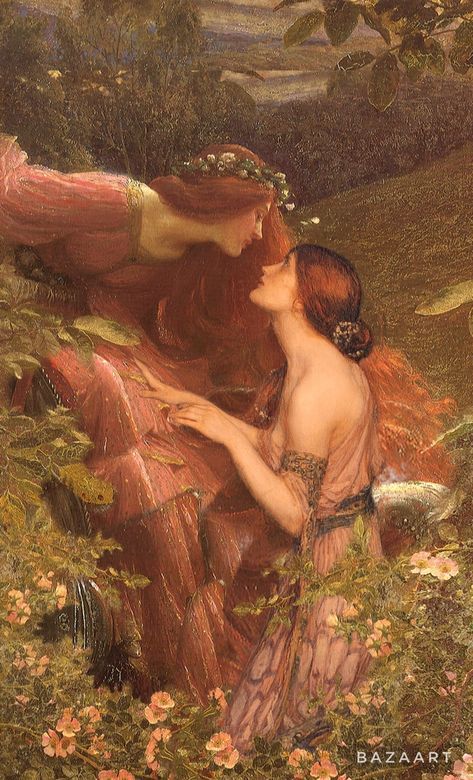





hand on the divine
your curves, like Italian marble
body as a work of art
not just a woman but a goddess
and i'm down on my knees
watermelon lingering on your tongue
i lap it up in waves
-Cleo on Hello Poetry
(https://hellopoetry.com/poem/4437773/body-as-a-work-of-art/)
#lesbian pride#lesbianism#lesbian#sapphic#gay girls#wlw#sapphism#sappho#wlw mood#wlw community#wlw blog#wlw love#wlw post#poem#beauty#beautiful#beauttiful girls#lovely#renaissance art#flowers#cottagecore#cottage aesthetic
216 notes
·
View notes
Text
A new Delicious Friend!

Good day, all, from Silvia Salcedo, the Revolution's Sappho! It is my chagrin pleasure to introduce you to my insufferable rake of a cousin, the cad and layabout charming Renaissance-man: Mr Winslow Velázquez! He is new to the Neath and has already made quite an impression in the eyes of the law, at least.
Winslow has asked me to alert my acquaintance that he is receiving visitors, and to encourage you to send him a calling-card. He is an ally of the Rubberies and has assured me that, one day soon, he shall finish his avant-garde opera, after he finishes this crate of wine.
(Art and character by my twin brother!!)
#here he is y'all!!!#poor silvia is not only plagued by an aunt but now a cousin as well#anyway my brother is a lot of fun and also likes writing letters in character#winslow velázquez#silvia salcedo#fallen london
40 notes
·
View notes
Text
Celebrate Pride by Learning About Ten Queer Independent Publishers!
This week, we’re spotlighting other queer, independent presses out there – some queer-owned, some focusing on publishing queer stories, some both. Take a look below - and if you know another press that’s not on the list, add it in the reblogs! The more queer publishers, the better. :D

Brown Recluse Zine Distro is a collectively run organization created to support and center zines by queer and trans people of color. Check out their shop for zines on dozens of topics, from personal reflection to political organizing.

Zombies Need Brains has been publishing themed anthologies for 10 years, and, this summer, they’re expanding to publish two short stories per month through their Patreon. Their next anthology’s theme will be announced in July; in the meantime, you can also pick up their previous anthologies and other ebooks in their store.

Interlude Press and their YA imprint, Duet Books, have published more than 90 works of LGBTQ+ fiction across genres. Their catalog is full of award-winners, and with the plethora of genres, they offer something for everyone.

All Worlds Wayfarer, a quarterly speculative literary magazine, has recently started producing themed anthologies as well. Their latest, Prismatic Dreams, contains 30 sci-fi, fantasy, and horror short stories with queer protagonists

Speculatively Queer “publishes speculative stories about queer hope, joy, love, affirmation, and community.” It Gets Even Better: Stories About Queer Possibility is available now, and Xenocultivars: Stories of Queer Growth is available for preorder.

Renaissance Press publishes diverse Canadian voices across genres. Their latest release is AfriCANthology: Perspectives of Black Canadian Poets.

Microcosm Publishing is a Portland-based publisher founded in 1996 to focus “on … the experiences of what it is like to be a marginalized person.” They especially focus on publishing work by women. They’ve currently got a Kickstarter running for their next title, “Unf*ck Your Grief.”

OFIC Mag is a small, new press focused on publishing a quarterly anthology featuring original stories and art by fanauthors and fanartists. They recently opened their third edition to submissions.

Ylva Publishing focusing on stories about women loving women, with an emphasis on diversity. They’re woman-owned and cross-genre, releasing everything from mysteries to romance to historical to erotica. They also publish YA titles!

Atthis Arts Indie Publishing is a small press named after a character from Sappho's poetry. They are especially interested in publishing works by members of underrepresented groups.
Bonus! An 11th Press
Space Wizard Science Fantasy, an indie press focused on queer sci-fi and fantasy, is just getting started. They've launched a Year 1 Kickstarter, featuring a number of titles they are working on, and they could really use more support. Back their current Kickstarter to purchase individual books or subscribe to the whole Year 1 slate of fiction!
#resources#on publishing#queer publishing#guest blogger#guest blogger adrian harley#original content#queer fiction
327 notes
·
View notes
Text
One of the first twentieth-century works to try to redress this pathological omission of women from what has conventionally been written as history is Mary Beard's Woman as a Force in History. Showing how, despite male dominance, women have in fact been important shapers of Western society, this pioneering woman historian led the way back into prehistory as a source of the lost human heritage. Of particular relevance here is Beard's documentation of something that to conventional historians would seem even more outrageous than the correlations shown by Winter and McClelland between "feminine" and "masculine" values and critical historical alternatives. This is that periods of the rising status of women are characteristically periods of cultural resurgence.
From the perspective of the Cultural Transformation theory we have been developing, it is hardly surprising to find a correlation between the status of women and whether a society is peaceful or warlike, concerned with people's welfare or indifferent to social equity, and generally hierarchical or equalitarian. For, as we have seen throughout this book, the way a society structures the relations between the two halves of humanity has profound, and highly predictable, systems implications. What is surprising is that, without any such theoretical framework, writing at the beginning of this century, Beard could see these patterns and remark on them in what is still one of few attempts to chart the activities of women in Western history.
In Women as a Force in History, Beard remarks on "the wide-reaching, and influential activities of Italian women in the promotion of humanistic learning" during the Renaissance. She notes that this was a time when women—along with "effeminate" values like artistic expression and inquiry—were beginning to free themselves from medieval church control. She documents that in the French Enlightenment of the seventeenth and eighteenth centuries women played similarly critical roles. Indeed, as we will see, during this period—which launched the secular revolt against what Beard calls "the barbarisms and abuses" of the old regime—it was in the "salons" of women like Madame Rambouillet, Ninon de Lenclos, and Madame Geoffrin that the ideas for what later became the more humanist, or in our terms more gylanic, modern ideologies first germinated.
This is not to say that women have not also helped to keep men and "masculine" values in power. Despite the emergence of great figures here and there, women's part in our recorded past was by necessity largely played in the androcratically prescribed role of the male's "helper." But as Beard repeatedly shows, although women have helped men fight wars, and sometimes even fought in them, theirs has generally been a very different role. For not being socialized to be tough, aggressive, and conquest-oriented, women in their lives, actions, and ideas have characteristically been "softer," that is, less violent and more compassionate and caring. For example, as Beard remarks, "one of the earliest—and perhaps the first—rivals of the hymnology of war, hatred, and revenge made immortal by Homer was the poetry of an Aeolian woman called Sappha by her people but uniformly known in later times as Sappho."
This insight is also found in another pioneering work focusing on the role of women in history: Elizabeth Gould Davis's The First Sex. Like books by other women trying to reclaim their past with no institutions or learned colleagues for support, Davis's book has been criticized for veering into strange, if not downright esoteric, flights of fancy. But despite their flaws and perhaps precisely because they did not conform to accepted scholarly traditions books like this intuitively foreshadow a study of history in which the status of women and so-called feminine values would become central.
Like Beard's, Davis's book puts women back into the places from which they were erased by androcratic historians. It also provides data that make it possible to see the connection at critical historical junctures between the suppression of women and the suppression of feminine values. For instance, Davis contrasts the Elizabethan age with the Puritan regression that followed, marked by virulent measures to repress women, including "witch" burnings.
But it is primarily in the works of today's more exacting feminist historians and social scientists that we can find the data needed to flesh out and develop a new holistic theory of gylanic-androcratic transformation and alternation. These are the works of women such as Renate Bridenthal, Gerda Lerner, Dorothy Dinnerstein, Eleanor Leacock, JoAnn McNamara, Donna Haraway, Nancy Cott, Elizabeth Pleck, Carroll Smith-Rosenberg, Susanne Wemple, Joan Kelly, Claudia Koonz, Carolyn Merchant, Marilyn French, Francoise d'Eaubonne, Susan Stownmiller, Annette Ehrlich, Jane Jaguette, Lourdes Arizpe, Itsue Takamure, Rayna Rapp, Kathleen Newland, Gloria Orenstein, Bettina Aptheker, Carol Jacklin, and La Frances Rodgers-Rose and men such as Carl Degler, P. Steven Sangren, Lester Kitkendal, and Randolph Trumbach, who, painstakingly, often using obscure, hard-to-find sources like women's diaries and other hitherto ignored records, are gradually reclaiming an incredibly neglected half of history. And in the process, they are producing the missing building blocks required to construct the kind of historical paradigm needed to understand, and move beyond, the one-step-forward-and-one-step-back alternations of recorded history. For it is in the new feminist scholarship that we begin to see the reason behind something the French philosopher Charles Fourier observed over a century ago: the degree of emancipation of women is an index of the degree of a society's emancipation.
-Riane Eisler, The Chalice and the Blade: Our History, Our Future
19 notes
·
View notes
Text


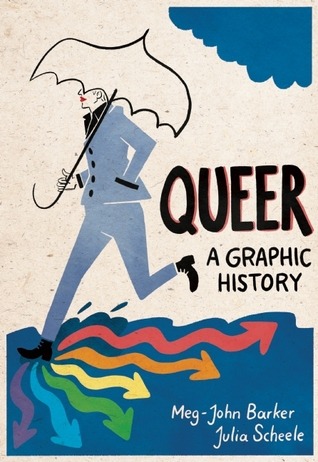
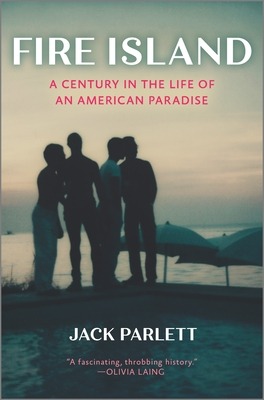
Nonfiction Thursday: LGBTQIA+ History Month
The LGBTQ+ History Book by DK Publishing
Exploring and explaining the most important ideas and events in LGBTQ+ history and culture, this book showcases the breadth of the LGBTQ+ experience. This diverse, global account explores the most important moments, movements, and phenomena, from the first known lesbian love poetry of Sappho to the Kinseys' modern sexuality studies, and features biographies of key figures from Anne Lister to Allen Ginsberg.
The LGBTQ+ History Book celebrates the victories and untold triumphs of LGBTQ+ people throughout history, such as the Stonewall Riots and first transgender surgeries, as well as commemorating moments of tragedy and persecution, from the Renaissance Italian “Night Police” to the 20th century “Don’t Ask Don’t Tell” policy. The book also includes major cultural cornerstones - the secret language of polari, Black and Latinx ballroom culture, and the many flags of the community - and the history of LGBTQ+ spaces, from 18th-century “molly houses” to modern “gayborhoods.”
The Gay Revolution by Lillian Faderman
The fight for gay and lesbian civil rights - the years of outrageous injustice, the early battles, the heart-breaking defeats, and the victories beyond the dreams of the gay rights pioneers - is the most important civil rights issue of the present day. In “the most comprehensive history to date of America’s gay-rights movement” (The Economist), Lillian Faderman tells this unfinished story through the dramatic accounts of passionate struggles with sweep, depth, and feeling.
The Gay Revolution begins in the 1950s, when gays and lesbians were criminals, psychiatrists saw them as mentally ill, churches saw them as sinners, and society victimized them with hatred. Against this dark backdrop, a few brave people began to fight back, paving the way for the revolutionary changes of the 1960s and beyond. Faderman discusses the protests in the 1960s; the counter reaction of the 1970s and early eighties; the decimated but united community during the AIDS epidemic; and the current hurdles for the right to marriage equality.
Queer: A Graphic History by Meg-John Barker & Jules Scheele
Activist-academic Meg John Barker and cartoonist Julia Scheele illuminate the histories of queer thought and LGBTQ+ action in this groundbreaking non-fiction graphic novel. A kaleidoscope of characters from the diverse worlds of pop-culture, film, activism and academia guide us on a journey through the ideas, people and events that have shaped 'queer theory'.
From identity politics and gender roles to privilege and exclusion, Queer explores how we came to view sex, gender and sexuality in the ways that we do; how these ideas get tangled up with our culture and our understanding of biology, psychology and sexology; and how these views have been disputed and challenged.
Along the way we look at key landmarks which shift our perspective of what's 'normal', such as Alfred Kinsey's view of sexuality as a spectrum between heterosexuality and homosexuality; Judith Butler's view of gendered behavior as a performance; the play Wicked, which reinterprets characters from The Wonderful Wizard of Oz; or moments in Casino Royale when we're invited to view James Bond with the kind of desiring gaze usually directed at female bodies in mainstream media.
Fire Island by Jack Parlett
Fire Island, a thin strip of beach off the Long Island coast, has long been a vital space in the queer history of America. Both utopian and exclusionary, healing and destructive, the island is a locus of contradictions, all of which coalesce against a stunning ocean backdrop.
Now, poet and scholar Jack Parlett tells the story of this iconic destination - its history, its meaning and its cultural significance - told through the lens of the artists and creators who sought refuge on its shores. Together, figures as divergent as Walt Whitman, Oscar Wilde, James Baldwin, Carson McCullers, Frank O'Hara, Patricia Highsmith and Jeremy O. Harris tell the story of a queer space in constant evolution.
Transporting, impeccably researched and gorgeously written, Fire Island is the definitive book on an iconic American destination and an essential contribution to queer history.
#lgbtqia history#nonfiction#nonfiction books#reading recommendations#reading recs#book recommendations#book recs#library books#tbr#tbr pile#to read#booklr#book tumblr#book blog#library blog#readers advisory
17 notes
·
View notes